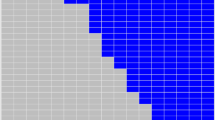Abstract
The state of the art on the issue of sex differences in research efficiency agrees in recognizing higher performances for males, however there are divergences in explaining the possible causes. One of the causes advanced is that there are sex differences in the availability of aptitude at the “high end”. By comparing sex differences in concentration and performance of Italian academic star scientists to the case in the population complement, this work aims to verify if star, or “high-end”, scientists play a preponderant role in determining higher performance among males. The study reveals the existence of a greater relative concentration of males among star scientists, as well as a performance gap between male and female star scientists that is greater than for the rest of the population. In the latter subpopulation the performance gap between the two sexes is seen as truly marginal.
Similar content being viewed by others
References
Abramo, G., D’Angelo, C. A. (2007), Measuring science: Irresistible temptations, easy shortcuts and dangerous consequences, Current Science, 93(6): 762–766.
Abramo, G., D’Angelo C. A., Pugini, F. (2008), The measurement of Italian universities’ research productivity by a non parametric-bibliometric methodology, Scientometrics 76(2): 225–244.
Abramo, G., D’Angelo, C. A., Caprasecca, A. (2009), Gender differences in research productivity: a bibliometric survey on the Italian academic system, Scientometrics, 79(3): 517–539.
Cole, J. R., Zuckerman, H. (1984), The productivity puzzle: persistence and change in patterns in publication of men and women scientists, Advances in Motivation and Achievement, 2: 217–258.
Etzkowitz, E., Kemelgor, C., Uzzi, B., Athena Unbound: The Advancement of Women in Science and Technology, Cambridge University press, 2002.
Fox, M. F. (1983), Publication productivity among scientists: a critical review, Social Studies of Science, 13(2): 285–305.
Fox, M. F. (2005), Gender, family characteristics, and publication productivity among scientists, Social Studies of Science 35(1): 131–150.
Fox, M. F., Mohapatra S. (2007), Social-organizational characteristics of work and publication productivity among academic scientists in doctoral-granting departments, Journal of Higher Education, 78(5): 543–571.
Hyde, J. S., Linn, M. C. (1988), Gender differences in verbal ability: A meta-analysis, Psychological Bulletin, 104: 53–69.
Hyde, J. S., Fennema, E., Lamon, S. J. (1990), Gender differences in mathematics performance: A meta-analysis, Psychological Bulletin, 107: 139–155.
Leahey, E. (2006), Gender differences in productivity: Research specialization as a missing link, Gender and Society, 20(6): 754–780.
Lee, S., Bozeman, B. (2005), The impact of research collaboration on scientific productivity, Social Studies of Science, 35(5): 673–702.
Lemoine, W. (1992), Productivity patterns of men and women scientists in Venezuela, Scientometrics, 24(2): 281–295.
Linn, M. C., Petersen, A. C. (1985), Emergence and characterisation of sex differences in spatial ability: A meta-analysis, Child Development, 56: 1479–1498.
Long, J. S. (1987), Problems and prospects for research on sex differences in the scientific career, In: L. S. Dix (Ed.) Women: Their Underrepresentation and Career Differentials in Science and Engineering, National Academy Press.
Long, J. S. (1992), Measure of sex differences in scientific productivity, Social Forces, 71(1): 159–178.
Mauleón, E., Bordons, M. (2006), Productivity, impact and publication habits by gender in the area of Materials Science, Scientometrics, 66(1): 199–218.
Moed, H. F. (2002), The impact factors debate: the ISI’s uses and limits, Nature, 415: 731–732.
Nowell, A., Hedges, L.V. (1995), Sex differences in mental test scores, variability and numbers of high-scoring individuals, Science, 269: 41–45.
Nowell, A., Hedges, L. V. (1998), Trends in gender differences in academic achievement from 1960 to 1994: An analysis of differences in mean, variance, and extreme scores, Sex Roles, 39(1/2).
Palomba, R., Menniti, A. (Eds), Minerva’s Daughters. Institute for Research on Population and Social Policies. Rome, Italy, 2001.
Pripiċ, K. (2002), Gender and productivity differentials in science, Scientometrics, 55(1): 27–58.
Stack, S. (2004), Gender, children and research productivity, Research in Higher Education, 45(8).
Summers, L. H., Remarks at NBER Conference on Diversifying the Science & Engineering Workforce, (Cambridge, Mass. — January 14), http://www.president.harvard.edu/speeches/2005/nber.html, 2005.
Voyer, D., Voyer, S., Bryden, M. P. (1995), Magnitude of sex differences in spatial ability: A meta-analysis and consideration of critical variables, Psychological Bulletin, 117: 250–270.
VTR-CIVR (2006), VTR 2001–2003. Risultati delle valutazioni dei Panel di Area, http://vtr2006.cineca.it/
Weingart, P. (2004), Impact of bibliometrics upon the science system: inadvertent consequences? In: H. F. Moed, W. Glänzel, U. Schmoch (Eds), Handbook on Quantitative Science and Technology Research, Dordrecht, The Netherlands, Kluwer Academic Publishers.
Xie, Y., Shauman, K. A. (1998), Sex differences in research productivity: New evidence about an old puzzle, American Sociological Review, 63: 847–870.
Xie, Y., Shauman, K. A. (2003), Women in Science: Career Processes and Outcomes, Harvard University Press, Cambridge, Massachusetts, and London, England
Zainab, A. N. (1999), Personal, academic and departmental correlates of research productivity: A review of literature, Malaysian Journal of Library & Information Science, 4(2): 73–110.
Zucker, L. G., Darby, M. R. (1996), Star scientists and institutional transformation: Patterns of invention and innovation in the formation of the biotechnology industry, Proceedings of the National Academy of Science of USA 93: 12709–12716.
Author information
Authors and Affiliations
Corresponding author
Rights and permissions
About this article
Cite this article
Abramo, G., D’Angelo, C.A. & Caprasecca, A. The contribution of star scientists to overall sex differences in research productivity. Scientometrics 81, 137–156 (2009). https://doi.org/10.1007/s11192-008-2131-7
Received:
Published:
Issue Date:
DOI: https://doi.org/10.1007/s11192-008-2131-7




